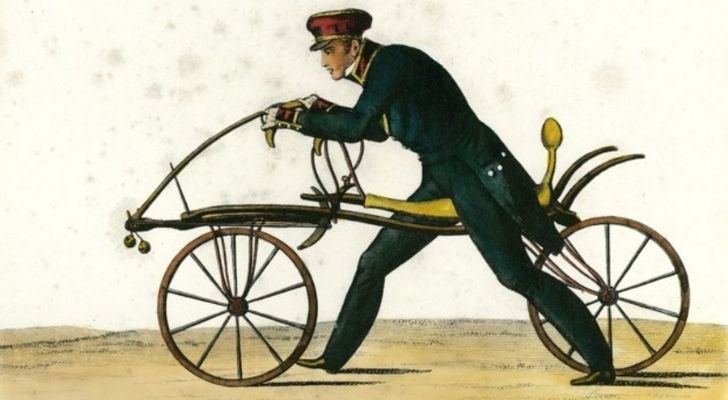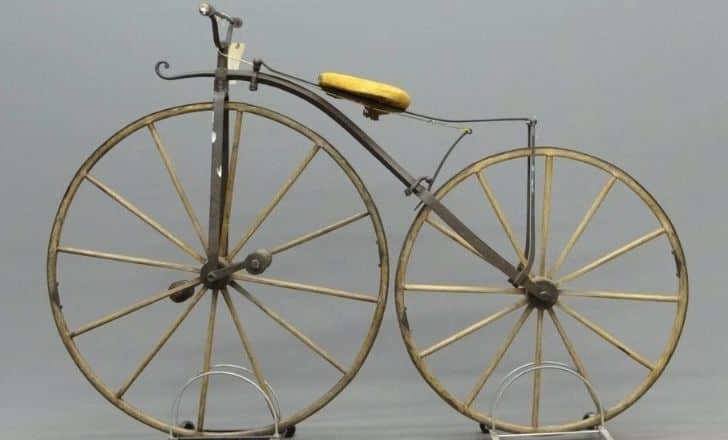Bicycles have been a mode of transport since the early 19th century.
Through the decades, the design has shaped them, developed them for better performance, and enhanced them so we can reach high speeds.
These human-powered vessels have served as the base of design for human-powered transportation.
But do you know who invented bicycles? Or when the first one was made?
In this article, we will explore the history of bicycles.
Who invented the first bicycle?

Bicycles have evolved throughout the past couple of hundred years, and it all began in 1817.
Karl von Drais, a German baron, designed a two-wheel contraption that was one of the first-ever bicycles made.
It was made from wood and didn’t have peddles, brakes, or a chain.
The rider would mount the bicycle and then kick off with their feet to gain momentum.
This invention gained many names such as; “hobby horse,” “running-machine,” and “velocipede.”
Drais is known as the father of bicycles.
When was the turning point in bicycle design?

It wasn’t until the 1860s when the bicycle really began to develop into the form that we use today.
French inventors Pierre Lallement, Pierre Michaux, and Ernest Michaux worked on creating bicycles with pedals.
Initial designs had the pedal attached to the front wheel, and these were what we know as penny-farthings.
The front-wheel was considerably larger than the back, and there were pedals on the front, with a small seat and handlebars.
This design became known as the “boneshaker” for its bumpy ride.
These really took off in the 1870s-1880s and were the inspiration for setting up bicycle clubs and competitive races.
In 1884 Englishman Thomas Stevens set off on a journey around the globe on a penny-farthing.
How did the “boneshaker” influence bicycle design?

Although the penny-farthing was the turning point in developing bicycle design, they were difficult to ride.
With a seat perched at 4 ft. (1.2 m), the bicycle was not only difficult to mount but unsafe if you were to fall.
Therefore in 1885, English designer John Kemp Starley invented the “safety bicycle” called the Rover.
This was a huge advancement in bicycle design at the time.
The safety bicycle had equally sized wheels and a chain drive, shortly followed by brakes and tires.
This was the template for what we call a bicycle today.
In the 1890s, bicycles became the latest fashion across Europe and the US.
In 1889 the first women’s safety bicycle was launched, making the mode of transport available to everyone.
The safety bicycle was the catalyst in designing human-powered transport.
When were unicycles invented?

Unicycles are one-wheeled bicycles, and surprisingly they were not invented before two-wheel bicycles.
The first design for a unicycle was patented in 1869, and it was based on the penny-farthing design.
Unicycles are considerably harder to ride than a bicycle with two wheels and therefore became associated with entertainers.
It took skill to mount and ride a unicycle as there were no handlebars for balance, and very few could do it successfully.
Are electric bicycles a modern adaption to the safety bicycle?

You might think that electric bicycles are a fairly modern adaptation to original human-powered bicycles, but they are just as old!
Shortly after the safety bicycle was designed, development into different types of bicycles began.
The first electric-powered bicycle was patented on December 31, 1895, by American inventor Ogden Bolton Jr.
This design had a 10-volt battery attached that would provide around 100 amps to the motor.
In 1897 Hosea W. Libbey invented an electric bicycle that had a double electric motor.
Japanese automotive company Yamaha built one of the first prototypes for an “e-bike” in 1989.
Development into electric bicycles continued for a few years in the US, but it wasn’t until the 1990s when there was considerable progress.
Who invented the folding bicycle?

It wasn’t until the early 20th century that people started to show an interest in the concept of a folding bicycle.
Danish engineer Mikael Pedersen invented the first folding bicycle in Britain in 1900.
It was developed for the British army and weighed 15 lb. (6.8 kg), and had 24 inch (60 cm) wheels.
Although it was designed for military use, it became popular with the public too.
The design was the first of its kind; however, it didn’t fold but separated into two parts.
Pederson’s “Folding & Military” bicycle was phased out within 4 years of launch.
It wasn’t until 60 years later, in 1962, when Moulton released their “Stowaway” model of folding bicycles, that these types of bicycles came back into fashion.
How many types of bicycles are there?

It is difficult to put a number on the exact number of bicycle designs available today, as there are many brands creating bicycles across the world.
Some of the most common types of bicycles are mountain bicycles, road bicycles, cruisers, tandems, BMX bicycles, and many more.
Bicycles have been designed to suit specific terrains and weathers as well as speeds.
You can find a bicycle for pretty much any type or style of riding, and many companies will custom build bicycles to suit your needs.
There are hundreds of bicycle designers and manufacturers worldwide, and there are between 15-20 million bicycles sold in the US every year.
Bicycles are an important mode of human-powered transport.
Without them, we would be reliant on walking, trains, or using vehicles which would limit our journeys.
Not only are they an eco-friendly way of getting about, but they are also a great form of daily exercise.


















